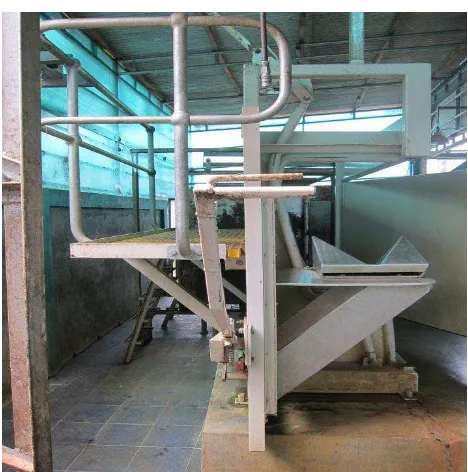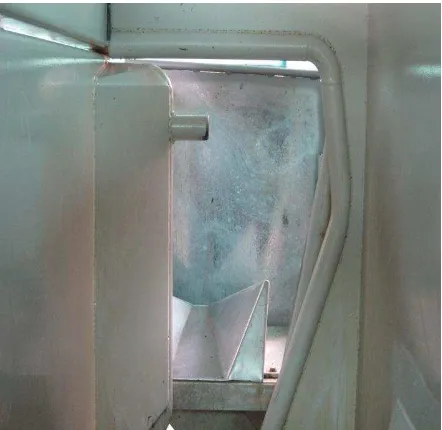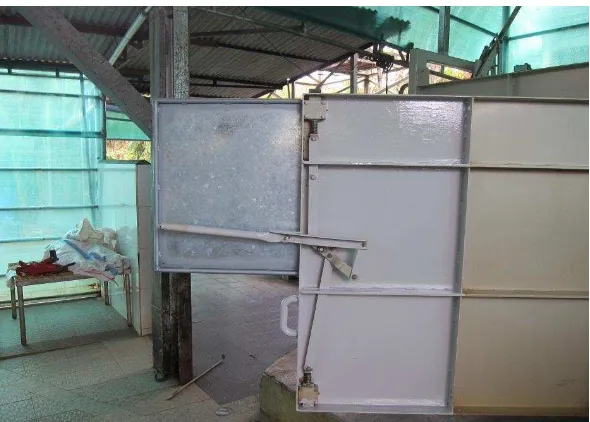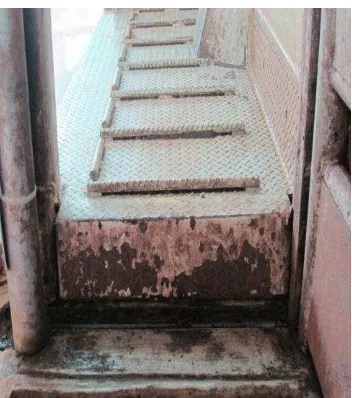This publication is published by Meat & Livestock Australia Limited ABN 39 081 678 364 (MLA). Care is taken to ensure the accuracy of Meat & Livestock Australia acknowledges the matching funds provided by the Australian Government to support the research and development detailed in this publication.
Project code: W.LIV.0397
Prepared by: Paul Troja
Felix Domus Pty Ltd
Date published: October 2013
ISBN: 9781741919721
PUBLISHED BY
Meat & Livestock Australia Limited Locked Bag 991
NORTH SYDNEY NSW 2059
Improving Standing Stun
Restraint in Indonesia
Addendum Report
Abstract
The installation of the Mark 1 restraining box conversion was completed in April 2012. When the device was able to be viewed in operation at the Sinar Mulya abattoir in Jakarta Indonesia, it was seen that further improvements could be made to meet with all of the DAFF and ESCAS
guidelines, and the OIE animal welfare standards for the slaughter of cattle with stunning. There were a number of operational and design elements of the restraining box that needed to be improved to facilitate a more consistent process and presentation of the animal at the point of slaughter.
Executive Summary
During a review of the restraint box conducted in April 2012, various mechanical and operational issues were identified. These were mainly associated with the presentation of the animal at the
point of slaughter and to minimise the animal’s stress levels during the restraining period just
prior to stunning. The aim is to provide a more consistent process.
The specific functionality issues of the proto type restraining box were:
The chin lift mechanism activation lever required the operator to stand in the animal’s line of sight.
The side door latch and locking device was in the animal’s line of sight and required the operator to stand on the dry landing area.
The belly plate that acts to move the animal’s centre of gravity towards the side door thus
providing quick and efficient discharge of the animal from the restraining device was not reliable on larger animals.
The head bale mechanism exhibits excessive lateral movement during application.
Overhead lighting of the area affected the animal’s movement in the cattle race and into the restraining box.
There is a step from the cattle race into the restraining box.
A further review of these issues has occurred with the exception of the overhead lighting and cattle race. These were considered to be site related and can be corrected by the abattoir operator. It should be noted that there was an obvious lack of basic maintenance of the
Contents
1
Glossary of Terms
... 5
2
Background
... 5
3
Project Objectives
... 5
4
Results and discussion
... 6
5
Conclusions
... 12
6
Success in achieving objectives
... 12
7
Recommendations
... 12
1
Glossary of Terms
OIE Office Internationale des epizooties, world organisation for animal health. DAFF The Australian Department of Agriculture Forestry and Fisheries.
ESCAS Export Supply Chain Assurance System. MLA Meat and Livestock Australia.
2 Background
The Australian Meat and Livestock industry acted to provide support to the Indonesian Meat and Livestock industry in the form of advice and selected technical assistance for better handling and processing of Australian livestock. One of the outcomes of this program was the development and installation of Mark 1 boxes for the restraining of Australian cattle in abattoirs throughout Indonesia. Due to non-compliant practices in relation to animal welfare emanating from the operation of the Mark 1 restraining box, MLA commissioned Felix Domus consultancy (service provider) to retro fit the existing Mark 1 box and to provide a prototype box with full operating instructions and construction drawings. This service was provided in November 2011, but due to timing and other administrative issues, the prototype restraining box was never commissioned and tested.
In April 2012, the Mark 1 restraining box conversion was viewed in operation at the Sinar Mulya abattoir located in Jakarta. As a result, a list of design and functionality improvements was presented to MLA for their consideration. This submission was subsequently considered by the MLA office in Jakarta and approved by the R&D committee.
On 1 October 2012, representatives travelled to Indonesia and performed some of the works as defined in the letter of offer dated 13 September 2012.
3 Project Objectives
During a review of the Mark 1 restraint conversion conducted in April 2012, various mechanical and operational issues were identified. These were mainly associated with the presentation of the animal at the point of slaughter during the restraining period just prior to stunning. The aim was to fully comply with OIE animal welfare standards for the stunning and slaughter of cattle.
To that end the project objectives became:
1. The chin lift ratchet mechanism has the following design functionality issues:
The location of the lift device is inappropriate and needs to be repositioned outside the
animal’s line of sight.
The operational aspects of the ratchet are physically difficult resulting is a slow response time in the application.
Screen the line of sight of the animal.
2. The side door latch needs to be relocated to a position under the chin lift line of operation thus allowing the operator to stand at ground level rather than on the dry landing concrete slab.
4. The head bale mechanism needs to be braced more effectively to reduced lateral movement
and make the animal’s head more accessible to the operator.
5. The lighting configuration needs to be adjusted to eliminate shadowing on the restraining box floor.
6. Attend to any other matter (within reason) that is of concern, that directly relates to the functionality of the restraining box, and that can be completed within the period of mission.
The program of work was to include:
1. Reconfirm the principles of humane slaughter through past and existing designs but enhance the application to ensure consistent and repeatable outcomes in presenting the animal for stun and transfer to the dry landing area adjacent to the restraining box.
2. Complete the Mark 1 restraining box conversion modifications in a location nominated by MLA.
3. In collaboration with MLA staff, conduct a stunning trial and make video and photographic records.
4. Make refinements and re-trial if necessary.
5. Update fabrication drawings to reflect the final working version.
6. Provide a final report written description of the operation, drawings and photographs.
4
Results and Discussion
The task of implementing the changes to the restraining box was influenced by discussions with the abattoir owners and operators who have a more comprehensive knowledge of the working environment and more particularly the site layout and restraining box location.
1. Chin Lift Operation.
Figure 1: End elevation of the restraining box and lever arm and ratchet that raises the chin restraint into place thus restricting lateral movement of the animal’s head.
The operational issue of concern is that if you reposition the lever mechanism to be at right angles to the restraining box and out of the direct line of sight of the animal, you cut off the operator access to the upper end of the cattle race and access to the stunning platform. After some discussion with abattoir management it was decided to leave the lever mechanism in its current location given that proper screening of the chin and head lift should adequately address
the ‘line of sight’ issue. A drawing has been included in the appendix to this report which outlines the lever mechanism at right angles to the restraining box, out of line of sight of the animal.
Figure 2: The side elevation of the lever arm and chin lift mechanism.
To facilitate a quicker and easier response time in raising the chin lift, a little oil and grease was applied to the guide rails and main support bearing thus reducing friction and improving
movement. It should be noted that the chin lift must fully engage the chin and head of the animal, so extra effort should be exercised by the operator to ensure proper contact.
Figure 3: Depicts the fixed screen that limits the animal’s vision
With the introduction of the end screen, the operator of the chin lift lever can no longer see the head and will have to rely on the stunner operator’s signal to lift the chin lift and to engage the head sufficiently to restrict lateral head movement.
Figure 4: An internal view of the chin lift, head bale and blocking screen.
2. Side door latch relocation.
is fixed to a concrete slab 30 centimetres above the ground proper thus positioning the latch handle higher and in line with the extended chin lift.
Figure 5: Side elevation of the side door handle and latch.
In Figure 5, a locking pin (not inserted) can be seen in the top right of the frame. This pin has been fitted by the operators to stop the animal’s head from accidentally opening the door during stunning. To further restrict the accidental opening of the side door by the lateral
movement of the animal’s head, the handle of the latch was bent from the chin lift as depicted in Figure 6.
Figure 7: The side elevation of the relocated locking latch and side screen completely enclosing the head capture area and restricting vision of the animal.
The side door handle and latch relocation and the additional fixed U shaped handle under the opening device now allows the door to opened at ground level and without any interference from
the live animal’s head movement.
3. Belly Plate Modification.
The original design and trialling of the restraining box in Australia tested cattle that were
approximately 450 kg live weight so the belly plate
was fitted
toward the front of the box with theexpectation of engaging the belly of the collapsed animal and forcing its weight against the side door. It became evident that the belly plate required modification for cattle above 450kg. Figure 8 shows the wear marks on the belly plate and rear end of the box floor which indicates that the animal in a collapsed position is not engaging the belly plate properly.
Figure 8: Side elevation of the restraining box depicting the original belly plate as described above.
Figure 9: Side elevation of the restraining box with an extended belly plate insert.
4. Head Bale.
Upon proper examination of the device it was clear that the problem of lateral movement is simply a lack of maintenance and regular adjustment of the fittings. The device is simple and easy to maintain, so any further refinement would provide little improvement and introduce a more complicated device in terms of operation and maintenance. It was therefore agreed to leave the device unaltered and reduce the lateral movement by adjusting the fittings.
Figure 10: The head bale mechanism and ratchet in a closed position.
5. Cattle race floor levels.
Figure 11: The step into the restraining box
6. Light Fittings Location over the Restraining Box.
The light intensity inside the restraining box and adjoining cattle race is lower than the surroundings. This will have an impact on the animal’s vision and ability to move forward. The solution to this issue lies with the local operator and can be fixed by repositioning the overhead lighting.
5
Conclusions
The W.LIV.0397 project objectives and deliverables have been fulfilled by the completion of these modifications and design adjustments and explanations as required. The conclusions and comments made in the original report, with the exception of the issues addressed in this work, are still relevant.
Proper training in the operation of this box is important and will greatly assist in improving the animal welfare standards and hygiene.
Proper maintenance is important so that the equipment can continue to work effectively. The restraining box is simple with very few moving parts so a monthly check and lubrication is recommended to ensure reliable operation.
6
Success in achieving objectives
The project’s primary goal of correction and improvement of specific operational issues that were identified as necessary to achieve overall compliance has been achieved.
7
Recommendations
The head bale restraining device modification has achieved the desired outcomes of adjusting existing infrastructure to allow for humane stunning and slaughter of cattle.




